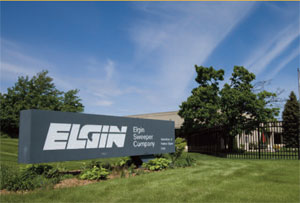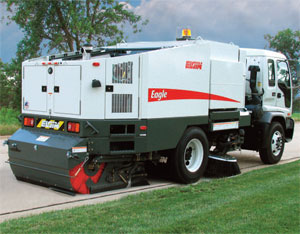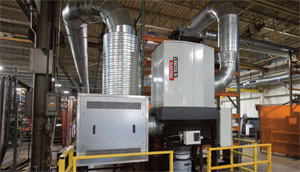ELGIN SWEEPER: LEADING MANUFACTURER OF ROADWAY SWEEPING TECHNOLOGY KEEPS AHEAD OF INDOOR AIR QUALITY CURVE
CHALLENGE
Upgrade weld fume extraction capabilities in the Elgin Sweeper Company’s high-volume chassis welding area to meet the OSHA Hexavalent Chromium Standard effective May 31, 2010.
SOLUTION
Custom engineered Push/Pull ventilation and filtration system from Lincoln Electric.
RESULTS
After 60 days of operation, roughly 15 gallons of particulate was removed from the air. It is estimated that 140 gallons will be removed on a yearly basis.
Fume control practices increasingly have become a significant focus in welding shops nationwide as the enforcement date nears for implementing engineering controls to meet the Occupational Health and Safety Administration (OSHA) regulations addressing exposure to hexavalent chromium [Cr(VI)].
As of May 31, 2010, shops that weld on stainless steel, alloy steel or hardfacing alloys containing chromium or use chromium-containing surface coatings, platings or consumables, must use engineering controls to reduce the permissible exposure of hexavalent chromium to less than 5 micrograms per cubic meter measured as an eight-hour, time-weighted average. This change is prompting welding shops nationwide to re-examine their fume control practices and their overall indoor air quality.
This increased focus on environmental responsibility isn’t new at Elgin Sweeper Co. Even before the engineering controls enforcement date was near, the company had begun making plans to upgrade its fume extraction as an intended step along its environmental path.
As the leading manufacturer of roadway sweeping technology, the Elgin, Illinois-based subsidiary of Federal Signal Corp. prides itself on delivering sustainable, environmentally preferential products by incorporating such sustainable features as regenerative air, alternative fuel and waterless dust control into its street sweeper technology. This “green” philosophy carries over into its manufacturing processes, including its busy welding shop.
“We walk the talk and are environmentally aware in our own location,” said David Strebel, Elgin’s safety manager. “We operate in a heavy welding environment – all of our products involve welded parts so obviously indoor air quality is a big consideration. We’ve always met OSHA standards and will continue to do so well before the new regulations take effect.”
In the spirit of staying ahead of the environmental curve, Elgin turned to Lincoln Electric to explore new customized options for fume extraction in the plant’s high-volume chassis welding area. As a result of the welding process, heated particulate matter from the fume layer collects in the air surrounding the work area and may also settle on the floor and work surfaces as it cools.
Elgin officials knew Lincoln offered the newest extraction solutions, including an innovative Push/Pull system that could be designed to meet the plant’s specific air quality needs. The Push/Pull ventilation system prevents the formation of a welding fume layer near the ceiling and rafters. Installed similarly to an HVAC system with a main ventilation unit and ductwork tailored to the needs of a particular workspace, the system assists in general air cleaning from overhead without any intervention on the part of welders working in the area.
Push/Pull systems create a cleaner work environment when used in conjunction with localized ventilation or breathing zone protection systems, especially in areas where capturing particulate at the source is difficult. They also work well in welding and metalworking environments for out-of-position and large-piece metal fabrication.
“The system’s engineering design makes it an effective choice for high-volume welding fume extraction because it removes the ambient airborne particulate,” said Tim Rosiek, application engineer at Lincoln Electric. “While the operational theory of such a system isn’t new, the way the Push/Pull system is designed and the ducting is routed is innovative in the welding industry.”
Maintaining Indoor Air Quality
Elgin welders fabricate many of the company’s sweeping products from the frame all the way through to the final
touches, Strebel says. The welding areas include a high-volume chassis fabrication area in the plant’s northeast
sector and a busy robotic area in the southeast corner. The robotic area features Lincoln Power Wave® 455M power sources, Lincoln Power Feed™ 10M wire feeders, Lincoln’s SuperArc® L-56 MIG (GMAW) welding wire, FANUC® ARC Mate® M120iB/10L robotic arms and R30iA controllers. The standard fume hood used in that area features a Lincoln Electric Statiflex® 6000-MS filter unit.
MIG welding on hot rolled steel accounts for about 98 percent of work performed in the welding shop on such parts as sweeper chassis, hoppers and general assembly. Welders do a small amount of TIG welding for specialized applications.
Because of its strong environmental commitment, coupled with its heavy welding environment, Elgin wanted to ensure levels remained well within air quality regulations and charged its safety committee with choosing an effective fume extraction solution for its heavy-traffic chassis fabrication area.
The committee quickly learned that selecting the best fume extraction system isn’t always a simple task. Numerous factors come into play, as no two shop floors, or even welding areas and materials within the same shop, are the same.
Lincoln representatives walked the safety team through a product selection process to help them choose the best
equipment for reducing the amount of particulates in the plant’s welding-intensive environment.
Many solutions can be used to provide welding fume control to protect workers from being overexposed. These include substitution, isolation, ventilation, work practices and, if the exposure cannot be adequately controlled, personal protective equipment. However, even with the successful implementation of one control method, there are times when it’s necessary to use a second method to further reduce particulates in the overall plant environment. Such instances may include work on large weldments, such as sweeper chassis.
With Lincoln’s guidance, the committee tried a variety of solutions and determined they needed a system that was both automatic and effective. Lincoln representatives suggested installing the new Push/Pull system, as its design and function appeared to most closely meet Elgin’s needs.
“The Push/Pull system’s design is extremely effective and efficient in removing ambient welding fume particulate suspended in the work area where the system is installed. The system also keeps wandering particulate from drifting to adjacent work areas. It’s located well above the workspace and does not interfere with any welding process, or other shop activities,” Rosiek said.
The fact that the system remained out of the workspace, yet still effectively cleaned the shop air, was the key selling point to Elgin officials, said Andy Divin, Elgin’s Lincoln technical representative.
How it Works
Lincoln Electric worked with Elgin to design a custom system by evaluating an in-depth inventory of the facility’s layout and operation. This inventory looked at such factors as application and manufacturing processes, operator procedures, existing ventilation and air movements, overall volume, obstructions and general workshop construction.
“Although the components of the system are not unusual, it’s the design and engineering of the system that are unique to each facility,” Rosiek said. “There’s no such thing as ‘plug and play’ when it comes to Push/Pull design.”
A typical Push/Pull system features four key elements that are tailored to each customer’s air cleaning needs:
Extraction – Ducts featuring airflow grids are designed according to the needs of each specific operation in order to move and extract the particulate layer in an efficient, controlled direction.
Filtration – As particulate moves through the extraction duct, it collects on the self-cleaning filter. When filter pressure reaches a set point, the internal, pneumatic, self-cleaning mechanism begins to clean the filter, dropping collected particulate into an easy-to-empty collection container.
Fan – A downstream-positioned fan unit, specifically sized for the system and powered by customizable, programmable controls, provides continuous extraction, filtration and re-circulation. To significantly reduce noise levels, the fan is mounted in a sound-absorbing box.
Re-circulation – Once particulate has been filtered from the air, the air can be re-circulated to push the particulate layer toward the extraction duct. To effectively control the direction of re-circulated air, a re-circulation duct with volume-regulated airflow grids is designed according to specific operating needs and facility layout.
The low-maintenance Push/Pull system requires no operator intervention and only minimal attention from the maintenance technicians. Typical maintenance includes cleaning the particulate collection container and periodically replacing the filter cartridge. A pressure meter measures the filter condition and saturation level in regards to collected particulate matter, indicating when the filter needs to be changed.
Immediate Results
Elgin’s system began operating in late January and immediately began clearing the air in the chassis work area. After 60 days, the safety team checked the filter collection container and removed roughly 15 gallons of particulate.
“We estimate our system, based on our first emptying of the collection container will remove 140 gallons of particulate from the air each year,” Strebel said. This cleaner environment has boosted employee morale and productivity, said Strebel, who credits some of recommendation to the welders on the safety committee.
“We truly believe in employee involvement in safety because they’re the ones out there on the floor. Their opinion matters,” he said. “People feel better about the work environment and are performing better now that the area is cleaner.”




